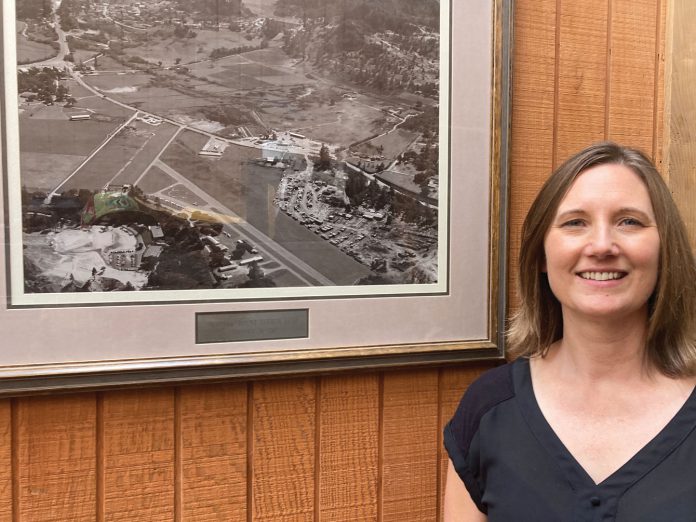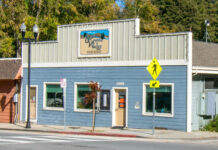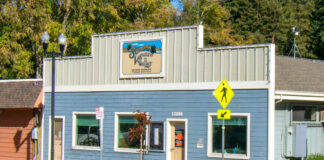
Not since the early-’90s has Scotts Valley been buoyed by so much potential for change, while facing so much risk to the surrounding environment due to expected development.
The plans to remake downtown suggest sleek, new buildings reminiscent of upper-middle-class areas of Cupertino, or the “Santana Row” mixed-use section of San Jose, and there are plenty of affordable homes, too.
The Town Center—to go where the Skypark airport once operated—has faltered before, and this latest version has yet to attract a developer. But there’s been steady progress this time, support from the community and the wind at the municipality’s back of a Department of Housing and Community Development that really wants to see wealthy communities like Scotts Valley actually build a significant number of residential units.
And now, the project has reached a key junction: the release of the Environmental Impact Report.
“The EIR looks at the impacts on flora and fauna,” said City Manager Mali LaGoe, in a sit-down interview at the bucolic City Hall offices, reflecting on this critical milestone. “It’s exciting that we have this really articulated vision.”
This 10-section document goes over everything from estimated annual energy use, to housing projections, to water demand. It piggybacks off of the 2025 Town Center Specific Plan (an update of the 2008 Town Center Specific Plan).
Recently, Scotts Valley City Council amended its EIR contract with David J. Powers & Associates, bringing the total up to around a quarter-million dollars.
The consultant analyzed the 58-acre redevelopment, including about 12.4 acres of vacant land, between Blue Bonnet Lane, Kings Village Road, Skypark Drive and Mount Hermon Road.
The EIR notes the Scotts Valley Water District has already accounted for the drinking water demand the Town Center would likely create.
It also points out that, when it comes to cultural impacts, there were stone tools found in the ground there, several years ago. However, these were excavated and removed in 2000.
“Within one mile of the Plan area, 11 cultural resources and 11 informal resources have been recorded,” the section reads. “Buildout under the Plan would not have the potential to impact these resources, as these resources are located outside of the Plan boundaries. Pursuant to SB 18 and AB 52, the City of Scotts Valley sent letters to tribes listed by the (California Native American Heritage Commission) as having a potential affiliation to the Plan area. The City did not receive any requests from the tribes to consult…and the Sacred Lands File results were also negative.”
LaGoe said the reason the environmental review pointed to fewer adverse impacts than what’s been predicted in other communities is because, although the land is vacant, it’s actually a redevelopment—an “infill” project.
“This property was an airport…it’s not like it was raw land,” she said. “A lot of those impacts are very minimal and have been studied for a very long time.”
Nevertheless, when humans enter a landscape that is undeveloped, or “underdeveloped,” this does shift the balance within the ecosystem, however slightly.
The EIR highlights this, noting how it could contribute to climate change. It states, for example, “the Plan would have a significant (Greenhouse Gas) emissions impact by not achieving carbon neutrality by 2045 in accordance with the State’s Scoping Plan. Therefore, the project would result in a cumulatively considerable contribution to a significant cumulative GHG emissions impact.”
LaGoe said this is essentially par for the course for most projects of this scope in California.
“The State set this goal, and didn’t put in any way of getting there,” she said. “I think the more we can do infill projects, the less we’re actually impacting the overall environment.”
And, she added, the City is required to take a variety of steps to mitigate whatever ecological harm will be done.
Unlike the Builder’s Remedy condo set to rise next to Los Gatos High School, just over the hill—where experts said the amount of total car and SUV trips (evaluated as “Vehicle Miles Traveled”) wouldn’t cause a significant rise in polluting-automobile activity—the Scotts Valley EIR revealed the Town Center “would contribute to a significant cumulative VMT impact.”
That being said, LaGoe countered, at least the revamped Town Center imagining is expected to drive reduced vehicle movement compared to the 2008 designs.
“This project actually has less impact,” she said, explaining this is because there’s more residential and not as much of a commercial component this time around. “The commercial really drives the Vehicle Miles Traveled.”
The EIR will face the public at the Planning Commission meeting on Nov. 20.
“We’ll be looking for input from the community,” said LaGoe, noting she’s committed to staying in compliance with State housing regulations by getting the environmental document before Council by the end of the year. “That’s what we’re on track for.”
If all goes well, they’ll start shopping for a developer just a few weeks later.
“I think 2026 will be a big year for really seeing how the Town Center will come together,” LaGoe said. “We’re really excited to work with the community to shape this vision.”












